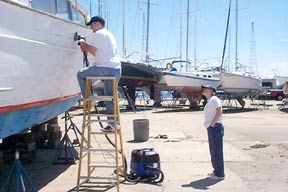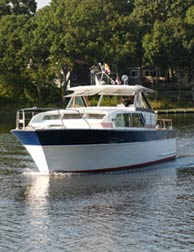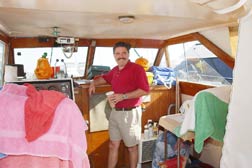|
|
story by Nancy Hoffmann
photos by Phil Hoffmann
John McGuire steered his boat along Cypress Creek, heading toward the Magothy River. Around the bend, a man waved urgently from shore. McGuire slowed as the signaler ran down the pier.

“What year is that?”
“She’s a ’63,” answered McGuire.
“Is it a Constellation?” asked the man.
“Yeah,” said McGuire.
“My wife wants me to buy it,” came the reply.
McGuire’s 37-foot Chris-Craft Constellation had just spent a month in drydock. This June afternoon was his first brush with the adoration she would arouse in boat lovers.
“There are so many beautiful boats,” says McGuire. “But for some reason, she catches people’s attention.”
Chris-Craft’s Heavenly Constellation
Introduced in 1954, the Constellation was a long-running classic for Chris-Craft. In 1972, the last wooden boat made by Chris-Craft — bought, incidentally, by NFL Commissioner Pete Roselle — was a Constellation. With the change to Fiberglas, the Constellation and her double-planked Philippine mahogany construction slipped into history.
In 2001, McGuire found his Constellation in the PennySaver. He had never owned a boat before, though he browsed boat ads. “I never thought I’d get involved with a boat any time soon,” he recalls.
There was something about this boat, however. “It caught my eye because of the age of it. And it was a Chris-Craft,” he says.
Boat Struck
Sitting in a marina on Kent Island, she was home to a family of four while their new house was built. Clothes were hung about the cabin, dishes were piled in the sink, a computer was on the dinette table, the television was mounted to the overhead and bunk beds were stacked on the starboard side.
McGuire didn’t notice. He saw only craftsmanship and ingenuity. A workman’s hands had set every fitting and hasp and placed every plank against her ribs. The earthy smell of her timbers made him think of older times, when everything seemed a little easier, even if it wasn’t.
Two experienced boating friends were just as smitten.
“I saw only her character and spirit and didn’t notice any flaws. She had a magnificence to her that was striking,” says Dee Jones, who had grown up in Missouri, boating on the Lake of the Ozarks, and who now keeps a ski boat on the South River.
Phil Hoffmann, who has boated on Chesapeake Bay for two decades, found her “beautiful and stately. I thought that with John, she’d have a chance at a new life, that she’d be cruising the seas again.”
It was December, a bad month to have a boat hauled out of the water for a survey. So McGuire plunged ahead without that assurance. “I figured common sense would say it was structurally sound because they were living on it with their children,” he says.
The only cure for such blindness was to buy her.
Three days after Christmas, McGuire and friends transported her across the Bay. It was a brave endeavor. Her twin Chevrolet engines had been replaced in 1986, but the Constellation had spent the past several years mostly tied to the pier.
“None of us knew if this was even going to make it out of the harbor, let alone across the Bay,” says McGuire.
With one engine running a little hot and a friend shadowing them, they cruised into the Magothy, the Constellation’s new home.
You Have a Boat
Four slings supported her keel as the Constellation rose from the water at Naval Station Annapolis. As she was driven to her drydock, one of the hard-hat crew attached himself to McGuire.
While the blocks and jack stands were positioned under the Constellation, the man talked. But when she was set down on her keel and the slings loosened, he grew quiet and watchful. When she sat, he said, “Congratulations. You have a boat.”
“I didn’t get it at first,” remembers McGuire.
“We were waiting to see if it was going to get fat or if we heard cracking as the ribs collapsed,” the workman said. “Because that means you’ve got a nice pile of firewood. So it survived and it’s in good shape.”
Getting her even so far had not been a piece of cake.
“
 |
| Friends, like Casey and Heidi Fox, volunteered time and labor to get the Chris-Craft Constellation refurbished and back into the water within a few weeks so that the hull did not dry out. |
When you tell people about a boat that age, that size, and then say it’s wooden and that you want it hauled out, everyone looks at you like you’re out of your mind,” McGuire says. “There aren’t a whole lot of people in Annapolis who know a whole lot about wooden boats.”
Maine, not Maryland, is said to be the place for wooden boatwork.
An exception is the Naval Station’s Ed Beck. McGuire, the video coordinator for Navy football, could use the marina through the Navy’s Morale, Welfare and Recreation Department, which provides services to military and civilian personnel. Beck hauled her out with the travel lift normally reserved for the Navy’s Yard Patrol craft.
Marina assistant Ken Taylor had served in the New Zealand Navy aboard wooden patrol boats and minesweepers, and he knew that every boat has its “weight points.” That’s where the slings went.
McGuire knows only that his boat was treated “like she was a precious piece of china.”
Out of the water, however, she looked like a broken, chipped and cracked piece of cheap pottery.
“One side of the boat looked like it had been hit by a shotgun blast,” remembers McGuire. “Hundreds of the bungs had popped out, exposing the screws that hold the boat together.”
The list of faults went on. Dry-rot had claimed the port quarter, the caulking had dried and split, the caulking cotton was rotten, the paint was peeling off, the brightwork was pitted and corroded, the propellers were dull, a hatch was sealed and the windows had been covered with Plexiglas.
“She looked like a derelict,” says McGuire. “Seeing her sitting there, getting a closeup view from below of the condition she was in, I kept wondering what I had been thinking.”
Other boat owners in the marina were eager to take a break from painting the bottoms of their fiberglass hulls and look over the Constellation. “You’ve got a lot of work here,” they liked to say.
A Lot of Work
Hoffmann and McGuire sanded along the port side. On the bow were Heidi and Casey Fox. Ellie Murpha was on the fantail, while Greg Morgan concentrated on the transom. The starboard side was taken down by Jones and Angela Muscat. McGuire’s friends had come out for a sanding and scraping party on the old Constellation’s Philippine mahogany.
Philippine mahogany “doesn’t have any particularly long-lasting qualities,” says marine carpenter Taylor. Nor is it really mahogany. What this cedar does have is “a tight grain so it doesn’t swell or shrink too much,” a quality that made it commonly used for boat making.
Today, Philippine mahogany is used in decking and furniture, but logging it is controversial. The Philippines and Thailand, once large exporters of the wood, are 80 percent deforested. Malaysia and Indonesia are well on their way to a similar fate. Chris-Craft once varnished all its boats to highlight the beautiful grains in the Philippine mahogany. After World War II, such high-quality wood was in short supply, and Chris-Craft turned to paint.
With 40 years of paint, caulk and gunk scraped from McGuire’s boat, all her flaws were exposed.
“Once she was out of the water,” he says, “I found out a lot of things about wooden boats.”
The first thing he learned was that a wooden boat is meant to be in the water.
“While in drydock,” says McGuire, “the biggest concern is that the wood will dry out. The bottom starts to shrink in a little over a week, and I knew I couldn’t get the work done in that amount of time.”
Following Beck’s advice, McGuire kept water in the bilge to slow the drying. It had to be saltwater, which helps preserve the wood. Freshwater will cause dry-rot. So every four or five days, McGuire hauled buckets of seawater from the Severn River and dumped them in the bilge. That was the easy part.
With free labor, the work progressed.
Hundreds of bung holes were routed out and the screwheads checked for oxidation. New bungs were placed in the holes then sheered off with chisel and hammer and sanded flush with the hull.
New caulking cotton, which swells and helps hold out the water, was placed in the seams above the waterline and all the seams were recaulked. The metal was shined or replated. Plexiglas was removed and the windows reset. The sealed hatch was opened and refinished. On the transom, the only portion of the boat not painted, a walnut stain was applied — followed by six coats of marine varnish.
 For the dry-rot, McGuire relied on Taylor, who cut out the rotten planks and machined new ones, using the old as guides. He also sanded down her bottom and applied two coats of paint.
For the dry-rot, McGuire relied on Taylor, who cut out the rotten planks and machined new ones, using the old as guides. He also sanded down her bottom and applied two coats of paint.
When McGuire was finally ready to paint above the waterline, he sought to recreate the color scheme originally used by Chris-Craft, a glossy white marked by a wide Navy blue band high on the hull, a red stripe at the water line and a few red and blue stripes on her cabin. McGuire rolled the paint on, and Jones followed behind him with a brush to draw out the grain of the wood.
As the work progressed, other boat owners at the marina returned, now to ask for advice or to admire. In one month out of water, she had been rejuvenated, and McGuire had become something of an expert.
Man the Pumps
“As we’re backing down the ramp, all I see is water coming in the boat,” McGuire recalls, with alarm. When the Constellation slid off the trailer and into the Severn River, he remembers thinking, “maybe I should just plot our rate of descent.”
“I knew she was going to leak, but I didn’t know how badly, how fast or for how long,” says McGuire. The owner’s manual warned that the boat would absorb water for several days and increase its weight by as much as 10 percent.
In the month the Constellation had been out of the water, her seams had opened up at least one-quarter inch. Some were wider.
“Laying under the boat,” Hoffmann recalls, “it seemed like you could look right into it. I could put my finger through some of the gaps.”
Even so, she needed to get back in the water.
So McGuire rented a sump pump, a generator and some hand pumps.
While he was pumping, he worried that he should have caulked the seams. But an old salt had warned him that as the caulked planks again swelled up, they would have nowhere to go and would warp and buckle. McGuire trusted the advice and scoured boat stores for a special sort of beeswax grease.
“I got a putty knife and spent the afternoon under the boat smearing this stuff into all the seams to close them up,” McGuire says. “As the wood expands, it squeezes the grease out because it’s very light.”
The treatment slowed, but didn’t stop the water’s rush into the wooden boat. Every 15 minutes, McGuire and Hoffmann turned on the generator to run the sump pump. Each time, water poured overboard.
Once they realized she wasn’t going to sink, they headed for the Magothy River.
By the time they reached the Magothy, the planks had begun to swell, and water was no longer gushing into the bilge. By Cypress Creek, where they tied up, water was only seeping in.
The Constellation still leaks, but McGuire doesn’t worry much anymore; he views the wood as part of the adventure.
“When we take a trip somewhere, especially out on the Bay, the boat has a lot of motion in her, everything is shifting and the water is seeping in,” he says. “When you get home, the bilge pump comes on quite frequently, but then it settles and everything is fine. It’s a living thing almost.”
Cruising to Another Era
Heading for home after a day on the Bay, the Constellation moves slowly along at 10 knots. Fishing boats, ski boats and cigarette boats race by. Bobbing gently in their wakes, the Constellation has no need to hurry the sunset or to rush the tide.
“She doesn’t go very fast,” says McGuire, “but she sets you up in a different frame of mind. You enjoy looking at her and listening to her as you cruise along.”
Friends like going out on the boat because “they feel like they’re in a nicer era,” he says.
 |
| John McGuire on That Guy the first day he saw her on Kent Island. |
“I enjoy the easy-goingness of it,” says Jones. “You don’t have to blast through the water, and there’s no shouting over the engines.”
Even Hoffmann, who owns a 25-foot Donzi named Fastbreak, admits he enjoys cruising. “Most of the boats today are about the destination. This boat is about the journey,” he says.
That Guy
“I used to rent 15-foot Boston Whalers and putter around the Severn River or go into Annapolis and along Spa Creek,” says McGuire. “I’d look at all the magnificent boats and see the people on them and I’d say, ‘Wow, look at that guy.”
“Now, I’m that guy.”
When McGuire counted the letters, seven for the seven seas, that’s what he named his Constellation: That Guy.
She’s an old wooden boat who’s spent her life cruising Chesapeake Bay. Is there a secret in her timbers, mere planks on ribs? Boaters seem to think so. They turn to look at her. They examine her and try to guess her age. Most know she’s a Chris-Craft. They like to touch her and ask permission to come aboard. What is she whispering to them?
About the Author:
Nancy Hoffmann, originally from New York, graduated from the United States Naval Academy. After serving six years on active duty, she attended the University of Maryland School of Law. She works in Annapolis as an attorney at the Court of Special Appeals. She’s an athlete and horsewoman. “Horsewoman” was the name of her first feature for Bay Weekly, in November of 2001. |
 |
Copyright 2002
Bay Weekly
|